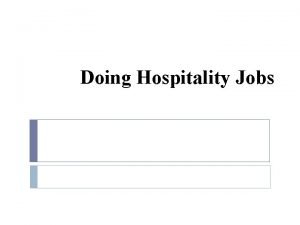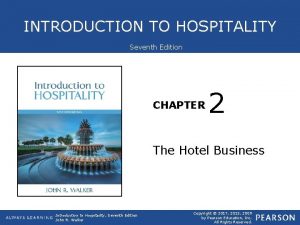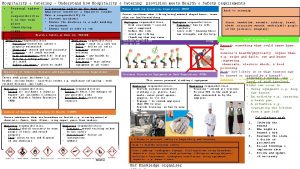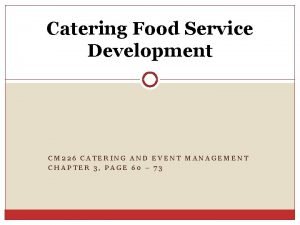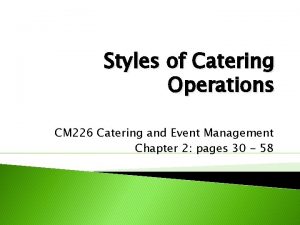The Hospitality Sector Introduction to the catering and














- Slides: 14

The Hospitality Sector

Introduction to the catering and Hospitality Industry The Hospitality and Catering Industry The Commercial Sector Contract Catering The Catering Service Sector Hotels Restaurants Health and Welfare Residential Public Houses Restricted Market Leisure and Tourism Educational Industry (Staff Feeding)

Hotels It is estimated that there are 12. 000 individuals hotels in the UK. With the addition of smaller hotels and guest houses the total is probably nearer 30. 000. the structure of hotels is identified in to the following categories: Budget hotels Bed and Breakfast One star Two stars Three star Four star Five star (luxury) Burj Al Arab hotel in Dubai

Hotels Large hotels chains have the market share of business and comprise the majority of hotels found across the world today. Aside from food and drinks service where chefs, kitchen assistant and service staff are required, hotels also employ staff in other specialized areas to cater for the accommodation and leisure facilities, such as: Reception Housekeeping Front office management Porter service Leisure management Events and banquets management

Types of restaurants

Restaurants The restaurant sector is the largest in the hospitality and catering industry. This had a steady increase of turnover and it is estimated that there are over 65. 000 restaurants in the UK. The restaurant industry is broken down into four different segments: Fast food establishments Cafes and coffee shops Mainstream restaurants Fine dining restaurants

There are various types of restaurants. Restaurants can be classified by whether they provide places to sit, whether they are served by wait-staff and the quality of the service, the formality of the atmosphere, and the price range. Historically, restaurant referred only to places which provide tables where one sits down to eat the meal, typically served by wait-staff. Following the rise of fast food and take-out restaurants, a retronym for the older "standard" restaurant was created, sit-down restaurant. Most commonly, "sit-down restaurant" refers to a casual dining restaurant with table service rather than a fast-food restaurant where one orders food at a counter. Sit-down restaurants are often further categorized as "family-style" or "formal". In British English, the term "restaurant" almost always means an eating establishment with table service, so the "sit-down" qualification is not usually necessary. Fast food and takeaway (takeout) outlets with counter service are not normally referred to as restaurants

The different types of Restaurants Fast food restaurants Casual dining Fine Dining Brasserie, bistro, pub

Fast food restaurants A common feature of fast food restaurants is a lack of cutlery or crockery, the customer is expected to eat the food directly from the disposable container it was served in using their hands. Another common name is Café or Deli. There are various types of fast-food restaurant: One orders at the counter; after preparation the food is brought to one's table; paying may be on ordering or after eating. One collects food from a counter and pays, then sits down and starts eating (self-service restaurant); sub-varieties: ◦ one collects ready portions ◦ one serves oneself from containers ◦ one is served at the counter

Casual dining A casual dining restaurant is a restaurant that serves moderatelypriced food in a casual atmosphere. Except for buffet-style restaurants, casual dining restaurants typically provide table service. Casual dining comprises a market segment between fast food establishments and fine dining restaurants. In France, it is also called Brasserie. The bill per diner at a casual dining restaurant usually averages £ 10 - £ 30 for an evening meal and slightly less for lunch, Casual Dining versus Bistro and Pub Most casual dining restaurants serve beer or wine with meals or include a bar where alcoholic beverages are served, but they are generally distinct from drinking establishments.

Fine Dining Fine dining is a phrase used to describe restaurants hat create a serious dining experience. The experience can start with the location and the view. The interior of such restaurants is often purported to be quite elegant and designed in accordance with the restaurant's concept. Service attempts to be impeccable, with chefs and service crew typically hailing from the best culinary schools. Restaurants fitting the fine dining label are normally highly rated; in the four star range and will provide more nuanced service and more expensive food than a standard sit-down restaurant.

Bistro & Pub A bistro is a familiar name for a café serving moderately priced simple meals in an unpretentious setting, especially in Paris; bistros have become increasingly popular with tourists. Mainly in the UK and other countries influenced by British culture, the pub (short for public house) today serves a similar dual menu, offering beer and other alcohol along with basic food fare. Traditionally, pubs were primarily drinking establishments, whereas the modern pub business relies on food as well, to the point where gastropubs are known for their high-quality "pub food".

Public Houses, Bars and Clubs A high proportion of the industry’s workforce is employed on a parttime basis. In this sector custom tends to be concentrated into a short number of hours so the amount of staff needed in peak hours is considerably higher than a quieter times. A relatively high proportion of this workforce describe their employment as casual, many of whom may be working in the industry while studying.

Public Houses, Bars and Clubs Public houses and bars provide alcoholic and non-alcoholic beverages. They are increasingly also providing snacks or food through a restaurant service. One way to segment the sector has been to look at ownership: Managed houses: include those which are owned by a brewery and employ salaried staff who mange work in the outlet Tenanted or leased pubs: are owned by a brewery but are occupied by licensees who pay a rent to the brewery to take their supply of beer and alcohol from them Freehouses: are owned and managed by the licensee and deal with a number of different suppliers and brewers
 Explain factors to consider when proposing dishes for menus
Explain factors to consider when proposing dishes for menus Wjec hospitality and catering revision
Wjec hospitality and catering revision Ac 2.1 hospitality and catering
Ac 2.1 hospitality and catering Wjec level 1/2 hospitality and catering
Wjec level 1/2 hospitality and catering Hospitality and catering revision
Hospitality and catering revision Wjec hospitality and catering
Wjec hospitality and catering Hospitality sector includes
Hospitality sector includes Introduction to catering
Introduction to catering An introduction to the catering industry
An introduction to the catering industry Introduction to hospitality and tourism industry
Introduction to hospitality and tourism industry Introduction to strategic hospitality technology investment
Introduction to strategic hospitality technology investment Food and beverage directors expect a pour cost of
Food and beverage directors expect a pour cost of Introduction to hospitality 7th edition
Introduction to hospitality 7th edition Introduction to hospitality 7th edition
Introduction to hospitality 7th edition John r walker introduction to hospitality management
John r walker introduction to hospitality management






